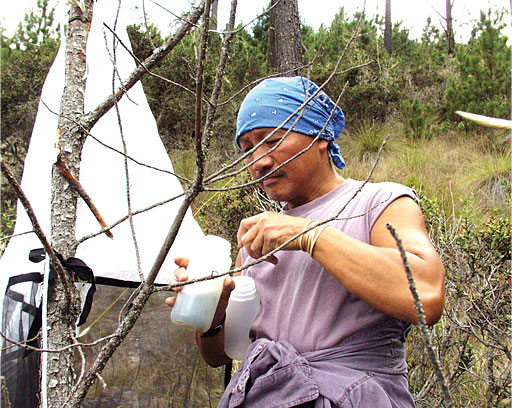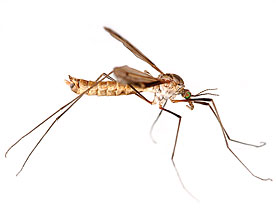 Winter 2009
Winter 2009|
“Crane flies don’t have much direct impact on us, but they’re very important food for many other animals—birds, lizards, frogs, even other insects.”
- Chen young
|
The Lord of the Flies
Carnegie Museum of Natural History scientist Chen Young has spent his life studying a single group of insects. On the occasion of his first solo exhibition, he talks about his labor of love.  Chen Young has collected crane flies from Scotland to Mongolia, the Arctic to the Amazon, and in western Pennsylvania. Here he is collecting in the Dominican Republic.The contents of each drawer Chen Young pulls open appear the same: row upon row of mosquito-like creatures, their long legs tucked like tiny platform divers, their wings frozen mid-flap, mounted for examination. A systematic entomologist, or insect scientist, in the Section of Invertebrate Zoology at Carnegie Museum of Natural History, Young maintains a dizzying array of such drawers, each containing scores of samples of this single creature that has become his life’s work: the humble and ubiquitous Diptera Tipulidae, better known as the crane fly. But as Young illustrates in Lord of the Crane Flies, an exhibition on view in the museum’s Third Floor Exhibitions Foyer, those thousands of specimens aren’t, as they might appear, multiples upon multiples of identical creatures. Rather, they’re among the 12,000 species of crane flies that exist worldwide, 1,500 in North America alone. He’s hoping that those sheer numbers, and the diversity of this single type of creature living all over the globe, will resonate with visitors the way they did with him some 35 years ago.  When Young was growing up in the Taiwan countryside of the 1950s and ‘60s, the diversity of life seemed endless, despite the fact that, as he points out, Taiwan is the size of Maryland. As a child, he brought home tadpoles and watched them grow into frogs; he collected butterflies; and, most of all, he watched the birds. When it came time to take his high school graduation exams, which are standardized tests designed to determine each student’s college proficiencies, Young chose to take the biology exam, and, as was mandatory, he ranked four disciplines that he might like to study. When Young was growing up in the Taiwan countryside of the 1950s and ‘60s, the diversity of life seemed endless, despite the fact that, as he points out, Taiwan is the size of Maryland. As a child, he brought home tadpoles and watched them grow into frogs; he collected butterflies; and, most of all, he watched the birds. When it came time to take his high school graduation exams, which are standardized tests designed to determine each student’s college proficiencies, Young chose to take the biology exam, and, as was mandatory, he ranked four disciplines that he might like to study. “For my first choice, I put down ornithology,” says Young. “Then, marine biology, animal husbandry, and entomology was my fourth choice. But my score was only good enough to do entomology!” For four years, Young studied entomology at National Chung-Hsing University in Taichung, central Taiwan. There, he discovered that, far from a disastrous fourth choice, insects were his true calling. “All of a sudden I realized, there are so many insects,” says Young. “And what’s more, I was good at it. I was good at telling the differences between them, and I really wanted to find out everything I could. Many of my classmates went into economic entomology—how to control certain insects such as pests. I just wanted to know what they were and how they related to one another.” What Young wanted, and has practiced ever since, is systematic entomology, the study of the biological diversity of insects; telling different species apart and discovering the life path and special history that explains how they’re related. Since Taiwan had no graduate program in systematic entomology, he would have to go to America. After two years as a paratrooper under Taiwan’s mandatory military service, Young attended the University of Kansas, which at the time had a strong systematic entomology program. And just as most Lord of the Crane Flies viewers will understand, when Young first encountered crane flies he figured they were all the same. In his very first class in Kansas, his professor handed him a jar filled with 100 identical-looking crane flies, telling him, “There are 20 different species in here.” Young’s innate curiosity kicked in. He was hooked, and has since earned a master’s degree and doctorate, all while studying that same creature with that same professor, George Byers. In 1980, he was hired by Carnegie Museum of Natural History to continue his life’s work. Since Byers’ retirement, Young is now one of only two crane fly experts in the United States. His website on crane flies of North America has become so important to their study that he’s now in the process of expanding it into a new project: TipWeb for Tipulidae, a worldwide online index of crane fly information. Crane flies, Young explains, are ubiquitous—he’s personally collected them everywhere from Scotland to Mongolia, the Arctic to the Amazon, to the fields of western Pennsylvania. They’re those long, lanky, non-biting “mosquitos” that hang around the porch light at night—only they’re not mosquitos. In the museum’s 10-year study of the insects of the Dominican Republic, Young collected at least 75 different species, only 10 of which were already known and identified, leaving him as discoverer of at least 65 new species. But in addition to being everywhere, or maybe because of it, crane flies are a foundation of the food chain in many habitats. “They’re one of the base providers,” says Young. “They don’t have much direct impact on us, but they’re very important food for many other animals—birds, lizards, frogs, even other insects. And their larvae, called leatherjackets because of how they move, are very picky about where they live. As a result they’re a reliable habitat indicator, so their absence can be a good indicator of whether or not water is polluted.” With Lord of the Crane Flies, the first exhibition solely devoted to Young’s work, he hopes that visitors will recognize that these animals are everywhere and that, simply, there’s a lot to learn about them and from them. “First off, how do you recognize crane flies?” asks Chen. “And then there’s information about their habitats, and their distribution all around the world, but particularly the tri-state area, because we’ve done very detailed study here. So, it’s about what they look like, where they live, and what they feed on. “Once people know a bit more about insects, they start to notice them more, and soon realize that we share the world with them. Once this great diversity is observed, the casual observer often wants to know even more. And once you see that, of course you want to know more.” |
Also in this issue:
The Art of Daily Life · Putting the Popular in Science · Welcome · Clearing a New Path · Directors' Note · NewsWorthy · Face Time: Lynn Zelevansky · Field Trip: For the Birds · Artistic License: Break-Out Performance · About Town: Social Science · Big Picture
 |
Copyright © 2017 CARNEGIE Magazine. All rights reserved. |
